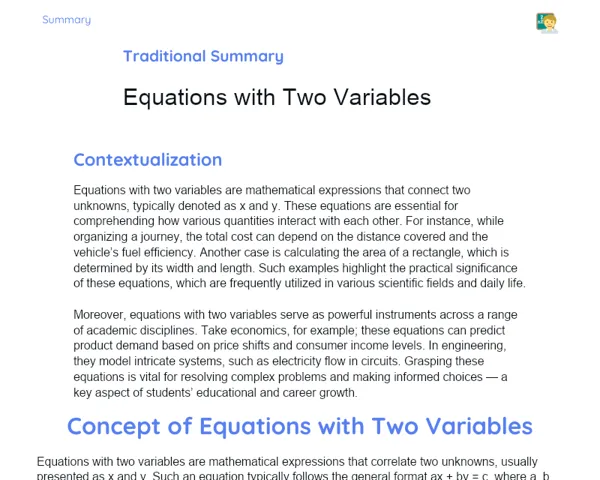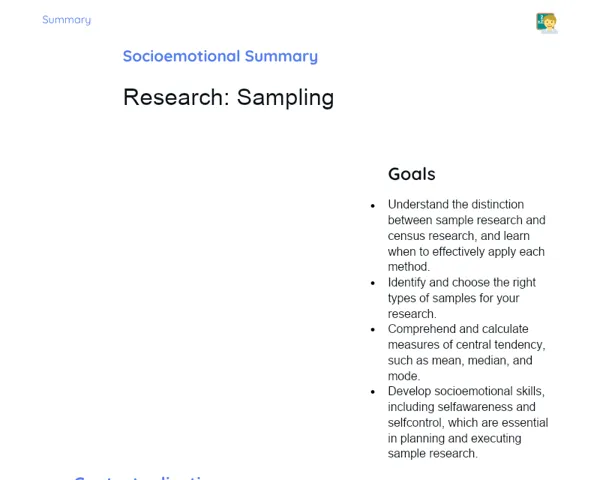Summary Tradisional | Arithmetic Progression: Sum
Contextualization
An Arithmetic Progression (AP) is a series of numbers where the gap between successive numbers remains constant. This constant gap is known as the common difference of the AP. We often witness such patterns in our daily lives – be it the regular increment of a pocket money or the steady upward growth of a plant, adding the same amount of height every week. Grasping this concept not only helps in forecasting future trends but also aids in solving problems in an organised and efficient manner.
In the world of mathematics, APs form the cornerstone for understanding sequences and series. Moreover, they find application in various subjects including finance, physics, and other practical situations. For instance, computing the total installments of a loan or summing values in a data sheet often requires summing up terms from an AP. Hence, a sound understanding of how to derive the sum of an AP not only simplifies complex mathematical problems but also enhances our comprehension of everyday phenomena.
To Remember!
Concept of Arithmetic Progression (AP)
An Arithmetic Progression (AP) refers to a sequence where every two successive numbers have the same difference. This difference, as already mentioned, is the common difference of the AP. For example, in the sequence 3, 6, 9, 12, ..., the gap between consecutive terms is 3. This means that by just adding 3 to any term, you get the next term in the series.
To check if a sequence is an AP, simply ensure that the difference between each pair of successive terms remains the same. Once this is confirmed, you can easily predict the next term. This concept is crucial not only to crack problems related to sequences but also because many real-world scenarios – like the gradual increase in a salary or the regular growth of a plant – follow this pattern.
-
AP is a sequence of numbers with a fixed difference between successive terms.
-
The fixed gap is known as the common difference.
-
Knowing this helps in predicting upcoming terms in the sequence.
General Term Formula of an AP
The formula for the nth term of an Arithmetic Progression lets us find any term directly, without having to list all the preceding terms. It is given by: a_n = a_1 + (n-1)d, where a_n is the nth term, a_1 is the first term, n is the term's position, and d is the common difference.
For example, consider the sequence 3, 6, 9, 12, ... where the first term (a_1) is 3 and d is 3. To calculate the 5th term (a_5), apply the formula: a_5 = 3 + (5-1)*3 = 15. This clearly shows the efficiency of using the formula to quickly find any term along the sequence.
This general term formula not only saves time but is also a handy tool in various computations, particularly in scenarios where we require a specific term from a lengthy series.
-
General term formula: a_n = a_1 + (n-1)d.
-
Helps in finding any term of the series without enumerating all earlier ones.
-
Simplifies solving problems that involve locating particular terms.
Sum of the Terms of an AP
The formula for summing the first n terms of an Arithmetic Progression is a practical tool in solving problems where several consecutive numbers need to be added. It is given by: S_n = (n/2) * (a_1 + a_n), where S_n is the sum of the first n terms, a_1 is the first term, and a_n is the nth term. Another equivalent form is S_n = (n/2) * [2a_1 + (n-1)d].
For instance, to calculate the sum of the first 10 terms of the sequence 3, 6, 9, 12, ..., we use: S_10 = (10/2) * (3 + 30) = 5 * 33 = 165. This is particularly useful for summing many items quickly, say, when calculating total loan repayments in EMIs.
Mastering this sum formula not only streamlines problem-solving but is also vital in diverse fields such as financial planning and data analytics.
-
Sum formulas: S_n = (n/2) * (a_1 + a_n) or S_n = (n/2) * [2a_1 + (n-1)d].
-
Enables efficient calculation of the total of consecutive terms in an AP.
-
Highly useful in practical applications such as EMI calculations.
Practical Examples
Let’s see how these formulas work in practice. Consider the AP 3, 6, 9, 12, ... where a_1 = 3 and d = 3. To find the sum of the first 10 terms, we compute: S_10 = (10/2) * [2*3 + (10-1)*3] = 5 * [6 + 27] = 5 * 33 = 165.
As another example, take the AP 2, 5, 8, 11, ... where a_1 = 2 and d = 3. The sum of the first 5 terms is given by: S_5 = (5/2) * [2*2 + (5-1)*3] = (5/2) * [4 + 12] = (5/2) * 16 = 40.
These examples clearly demonstrate the practicality of AP formulas. Regular practice with such problems not only reinforces the underlying concepts but also prepares students to apply these techniques in real-life situations, be it in academic assessments or day-to-day computations.
-
Example 1: Sum of the first 10 terms of the sequence 3, 6, 9, 12, ... comes out to be 165.
-
Example 2: Sum of the first 5 terms of the sequence 2, 5, 8, 11, ... is calculated as 40.
-
Practice aids in cementing the concept and application of AP formulas.
Key Terms
-
Arithmetic Progression (AP): A sequence with a constant gap between consecutive numbers.
-
Common Difference: The fixed gap between successive terms in an AP.
-
General Term of an AP: The formula a_n = a_1 + (n-1)d to compute any term.
-
Sum of Terms of an AP: The formula S_n = (n/2) * (a_1 + a_n) or S_n = (n/2) * [2a_1 + (n-1)d] to calculate the total of the first n terms.
Important Conclusions
In the lesson, we explored the concept of an Arithmetic Progression (AP), focusing on the formula for finding any specific term and the formula for adding up the terms. These formulas are invaluable in efficiently solving problems related to sequences and have a host of applications in everyday life as well as in subjects like finance and physics.
The formula for the nth term (a_n = a_1 + (n-1)d) eliminates the need to list all the earlier terms, offering a quick solution. Likewise, the sum formula (S_n = (n/2) * (a_1 + a_n) or S_n = (n/2) * [2a_1 + (n-1)d]) allows us to calculate totals rapidly, even when dealing with a large number of terms.
By working through these examples and formulas, students not only gain clarity but also acquire a robust toolset for tackling real-life problems. With continued practice and exploration, the concepts of AP will become second nature, paving the way for deeper mathematical understanding.
Study Tips
-
Revise and practice the examples discussed in class to strengthen your grasp on AP formulas.
-
Attempt additional problems that apply the general term and sum formulas to enhance your skills.
-
Look out for everyday situations, such as calculating EMIs or observing steady growth patterns, where APs naturally apply.



